Aquatic Invertebrates
Media
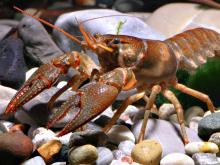
Species Types
Scientific Name
Faxonius quadruncus (formerly Orconectes quadruncus)
Description
The St. Francis River crayfish is rather small and dark brown, with blackish blotches or specks over the upper surfaces of the pincers, carapace, and abdomen. It is limited to the St. Francis River and its tributaries.
Media
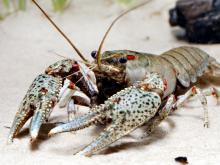
Species Types
Scientific Name
Faxonius palmeri (formerly Orconectes palmeri)
Description
The gray-speckled crayfish is gray with numerous greenish-black speckles and blotches. A pair of large blotches are present near the back of the head, and another pair occur where the carapace joins the abdomen. In Missouri, it is found only in the southeastern section.
Media
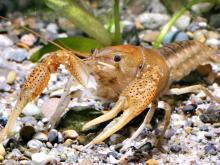
Species Types
Scientific Name
Procambarus acutus
Description
Adult White River crawfish are usually a deep burgundy red with a black V-shaped stripe on the abdomen. Juveniles are gray with dark spots scattered over the carapace. In Missouri, this species mostly occurs in the Bootheel and north along the Mississippi River.
Media

Species Types
Scientific Name
Cambarellus shufeldtii
Description
Shufeldt’s dwarf crayfish is small, reddish brown to gray, with a paired series of dark, wavy stripes or dashes along the dorsal surface. In Missouri, it occurs in our southeastern lowlands and north along the Mississippi River floodplain.
Media
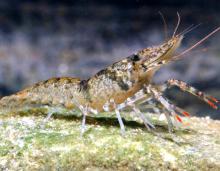
Species Types
Scientific Name
Faxonius lancifer (formerly Orconectes lancifer)
Description
The shrimp crayfish is medium-small, light reddish brown to gray, and thickly dusted with darker specks. Its noselike rostrum is unusually long, with the tip longer than the base, and the pincers are narrow and weak. It is found in the Bootheel.
Media
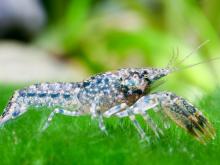
Species Types
Scientific Name
Cambarellus puer
Description
The Cajun dwarf crayfish is small, reddish brown to gray, with a paired series of dark, wavy stripes or dashes along the dorsal surface. In Missouri, it occurs in our southeastern lowlands.
Media
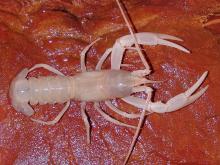
Species Types
Scientific Name
Orconectes stygocaneyi
Description
One of three species of cave crayfish in Missouri, the Caney Mountain cave crayfish is known from only one location. Like many other cave invertebrates, this species is whitish and is blind.
Media

Species Types
Scientific Name
Faxonius immunis (formerly Orconectes immunis)
Description
The calico crayfish is rather plain: gray-green with a pale central zone along the middle of the carapace and abdomen. The pincers are orange-tipped, and in mature males are tinged with purple. It is usually only found in the northern half of the state.
Media

Species Types
Scientific Name
Bivalve molluscs in order Unionoida
Description
Secretive and seldom seen, freshwater mussels are extraordinarily diverse in Missouri. We have nearly 70 species within our borders. Many are declining, and several are endangered.
Media

Species Types
Scientific Name
Over 20 Missouri species in former subclass Prosobranchia
Description
Gilled snails are one of two main groups of aquatic snails in Missouri (the other group is the "lunged" snails). Gilled snails, or prosobranchs, breathe with gills and possess a hard trapdoor-like operculum. They are most common in the Ozarks.
See Also
About Aquatic Invertebrates in Missouri
Missouri's streams, lakes, and other aquatic habitats hold thousands of kinds of invertebrates — worms, freshwater mussels, snails, crayfish, insects, and other animals without backbones. These creatures are vital links in the aquatic food chain, and their presence and numbers tell us a lot about water quality.





















